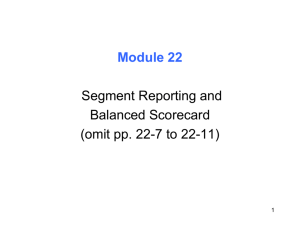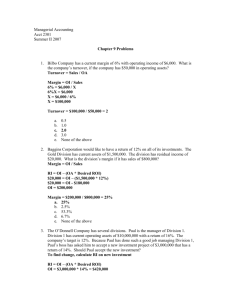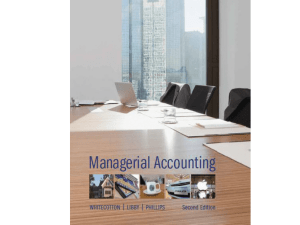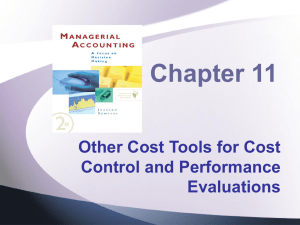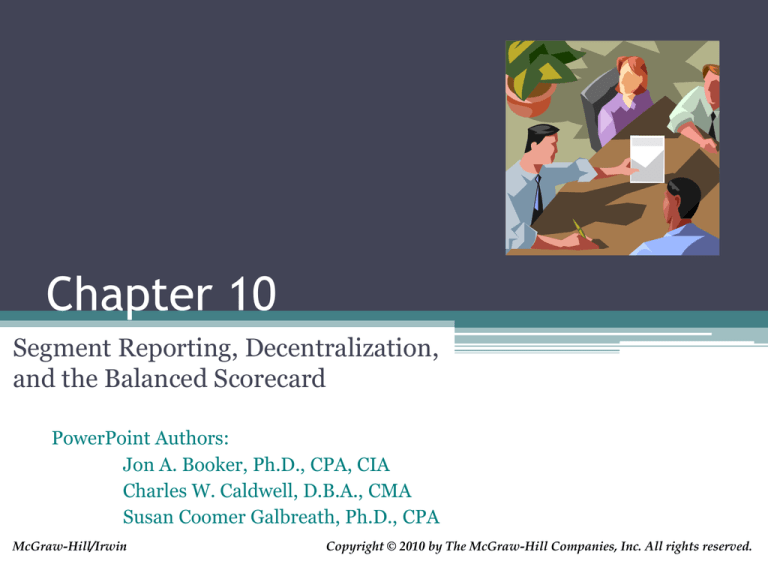
Chapter 10
Segment Reporting, Decentralization,
and the Balanced Scorecard
PowerPoint Authors:
Jon A. Booker, Ph.D., CPA, CIA
Charles W. Caldwell, D.B.A., CMA
Susan Coomer Galbreath, Ph.D., CPA
McGraw-Hill/Irwin
Copyright © 2010 by The McGraw-Hill Companies, Inc. All rights reserved.
10-2
Decentralization in Organizations
Advantages of
Decentralization
Lower-level managers
gain experience in
decision-making.
Top management
freed to concentrate
on strategy.
Decision-making
authority leads to
job satisfaction.
Lower-level decisions
often based on
better information.
Lower level managers
can respond quickly
to customers.
10-3
Decentralization in Organizations
Lower-level managers
may make decisions
without seeing the
“big picture.”
Lower-level manager’s
objectives may not
be those of the
organization.
May be a lack of
coordination among
autonomous
managers.
Disadvantages of
Decentralization
May be difficult to
spread innovative ideas
in the organization.
10-4
Responsibility Accounting
Cost
Center
Cost, profit,
and investment
centers are all
known as
responsibility
centers.
Profit
Center
Responsibility
Center
Investment
Center
10-5
Cost Center
A segment whose manager has control
over costs, but not over revenues or
investment funds.
10-6
Profit Center
A segment whose
manager has control
over both costs and
revenues,
but no control over
investment funds.
Revenues
Sales
Interest
Other
Costs
Mfg. costs
Commissions
Salaries
Other
10-7
Investment Center
Corporate Headquarters
A segment whose
manager has
control over costs,
revenues, and
investments in
operating assets.
10-8
Responsibility Centers
Investment
Centers
Operations
Vice President
Salty Snacks
Product Manger
Bottling Plant
Manager
Beverages
Product Manager
Warehouse
Manager
Superior Foods Corporation
Corporate Headquarters
President and CEO
Finance
Chief FInancial Officer
Legal
General Counsel
Personnel
Vice President
Confections
Product Manager
Distribution
Manager
Cost
Centers
Superior Foods Corporation provides an example of the
various kinds of responsibility centers that exist in an
organization.
10-9
Responsibility Centers
Superior Foods Corporation
Corporate Headquarters
President and CEO
Operations
Vice President
Salty Snacks
Product Manger
Bottling Plant
Manager
Beverages
Product Manager
Warehouse
Manager
Finance
Chief FInancial Officer
Legal
General Counsel
Personnel
Vice President
Confections
Product Manager
Distribution
Manager
Profit
Centers
Superior Foods Corporation provides an example of the
various kinds of responsibility centers that exist in an
organization.
10-10
Responsibility Centers
Superior Foods Corporation
Corporate Headquarters
President and CEO
Operations
Vice President
Salty Snacks
Product Manger
Bottling Plant
Manager
Beverages
Product Manager
Warehouse
Manager
Finance
Chief FInancial Officer
Legal
General Counsel
Personnel
Vice President
Confections
Product Manager
Distribution
Manager
Cost
Centers
Superior Foods Corporation provides an example of the
various kinds of responsibility centers that exist in an
organization.
10-11
Learning Objective 1
Prepare a segmented income
statement using the contribution
format, and explain the difference
between traceable fixed costs
and common fixed costs.
10-12
Decentralization and Segment Reporting
An Individual Store
Quick Mart
A segment is any part or
activity of an organization
about which a manager
seeks cost, revenue, or
profit data.
A Sales Territory
A Service Center
10-13
Superior Foods: Segmented by
Geographic Regions
Superior Foods Corporation
$500,000,000
East
$75,000,000
Oregon
$45,000,000
West
$300,000,000
Washington
$50,000,000
Midwest
$55,000,000
California
$120,000,000
South
$70,000,000
Mountain States
$85,000,000
Superior Foods Corporation could segment its business
by geographic region.
10-14
Superior Foods: Segmented by
Customer Channel
Superior Foods Corporation
$500,000,000
Convenience Stores
$80,000,000
Supermarket Chain A
$85,000,000
Supermarket Chains
$280,000,000
Supermarket Chain B
$65,000,000
Wholesale Distributors
$100,000,000
Supermarket Chain C
$90,000,000
Drugstores
$40,000,000
Supermarket Chain D
$40,000,000
Superior Foods Corporation could segment its business
by customer channel.
10-15
Keys to Segmented Income
Statements
There are two keys to building
segmented income statements:
A contribution format should be used
because it separates fixed from variable
costs and it enables the calculation of a
contribution margin.
Traceable fixed costs should be separated
from common fixed costs to enable the
calculation of a segment margin.
10-16
Identifying Traceable Fixed Costs
Traceable costs arise because of the
existence of a particular segment and would
disappear over time if the segment itself
disappeared.
No computer
division means . . .
No computer
division manager.
10-17
Identifying Common Fixed Costs
Common costs arise because of the overall
operation of the company and would not
disappear if any particular segment were
eliminated.
No computer
division but . . .
We still have a
CEO.
10-18
Traceable Costs Can Become
Common Costs
It is important to realize that the traceable
fixed costs of one segment may be a
common fixed cost of another segment.
For example, the landing fee
paid to land an airplane at an
airport is traceable to the
particular flight, but it is not
traceable to first-class,
business-class, and
economy-class passengers.
10-19
Segment Margin
Segment Margin
The segment margin, which is computed by
subtracting the traceable fixed costs of a segment
from its contribution margin, is the best gauge of
the long-run profitability of a segment.
Time
10-20
Traceable and Common Costs
Fixed
Costs
Traceable
Don’t allocate
common costs to
segments.
Common
10-21
Activity-Based Costing
Activity-based costing can help identify how costs
shared by more than one segment are traceable to
individual segments.
Assume that three products, 9-inch, 12-inch, and 18-inch pipe, share 10,000
square feet of warehousing space, which is leased at a price of $4 per square foot.
If the 9-inch, 12-inch, and 18-inch pipes occupy 1,000, 4,000, and 5,000 square
feet, respectively, then ABC can be used to trace the warehousing costs to the
three products as shown.
Pipe Products
9-inch
12-inch
18-inch
Total
Warehouse sq. ft.
1,000
4,000
5,000
10,000
Lease price per sq. ft. $
4 $
4 $
4 $
4
Total lease cost
$
4,000 $
16,000 $
20,000 $
40,000
10-22
Levels of Segmented Statements
Webber, Inc. has two divisions.
Webber, Inc.
Computer
Division
Television
Division
Let’s look more closely at the
Television Division’s income
statement.
10-23
Levels of Segmented Statements
Our approach to segment reporting uses the
contribution format.
Income Statement
Contribution Margin Format
Television Division
Sales
$ 300,000
Variable COGS
120,000
Other variable costs
30,000
Total variable costs
150,000
Contribution margin
150,000
Traceable fixed costs
90,000
Segment margin
$ 60,000
Cost of goods
sold consists of
variable
manufacturing
costs.
Fixed and
variable costs
are listed in
separate
sections.
10-24
Levels of Segmented Statements
Our approach to segment reporting uses the
contribution format.
Income Statement
Contribution Margin Format
Television Division
Sales
$ 300,000
Variable COGS
120,000
Other variable costs
30,000
Total variable costs
150,000
Contribution margin
150,000
Traceable fixed costs
90,000
Segment margin
$ 60,000
Contribution margin
is computed by
taking sales minus
variable costs.
Segment margin
is Television’s
contribution
to profits.
10-25
Levels of Segmented Statements
Income Statement
Company
Television
Sales
$ 500,000
$ 300,000
Variable costs
230,000
150,000
CM
270,000
150,000
Traceable FC
170,000
90,000
Segment margin
100,000
$ 60,000
Common costs
Net operating
income
Computer
$ 200,000
80,000
120,000
80,000
$ 40,000
10-26
Levels of Segmented Statements
Income Statement
Company
Television
Computer
Sales
$ 500,000
$ 300,000
$ 200,000
Variable costs
230,000
150,000
80,000
CM
270,000
150,000
120,000
Traceable FC
170,000
90,000
80,000
Segment margin
100,000
$ 60,000
$ 40,000
Common costs
25,000
Common costs should not
Net operating
be allocated to the
income
$ 75,000
divisions. These costs
would remain even if one
of the divisions were
eliminated.
10-27
Traceable Costs Can Become
Common Costs
As previously mentioned, fixed costs that are
traceable to one segment can become common
if the company is divided into smaller
segments.
Let’s see how this works using
the Webber, Inc. example!
10-28
Traceable Costs Can Become
Common Costs
Webber’s Television Division
Television
Division
LCD
Plasma
Product
Lines
10-29
Traceable Costs Can Become
Common Costs
Income Statement
Television
Division
LCD
Sales
$ 200,000
Variable costs
95,000
CM
105,000
Traceable FC
45,000
Product line margin
$ 60,000
Common costs
Divisional margin
Plasma
$ 100,000
55,000
45,000
35,000
$ 10,000
We obtained the following information from
the LCD and Plasma segments.
10-30
Traceable Costs Can Become
Common Costs
Income Statement
Television
Division
LCD
Sales
$ 300,000
$ 200,000
Variable costs
150,000
95,000
CM
150,000
105,000
Traceable FC
80,000
45,000
Product line margin
70,000
$ 60,000
Common costs
10,000
Divisional margin
$ 60,000
Plasma
$ 100,000
55,000
45,000
35,000
$ 10,000
Fixed costs directly traced
to the Television Division
$80,000 + $10,000 = $90,000
10-31
External Reports
The Financial Accounting Standards Board now requires
that companies in the United States include segmented
financial data in their annual reports.
1.
Companies must report segmented
results to shareholders using the same
methods that are used for internal
segmented reports.
2.
Since the contribution approach to
segment reporting does not comply
with GAAP, it is likely that some
managers will choose to construct
their segmented financial statements
using the absorption approach to
comply with GAAP.
10-32
Omission of Costs
Costs assigned to a segment should include
all costs attributable to that segment from the
company’s entire value chain.
Business Functions
Making Up The
Value Chain
R&D
Product
Design
Customer
Manufacturing Marketing Distribution Service
10-33
Inappropriate Methods of Allocating
Costs Among Segments
Failure to trace
costs directly
Segment
1
Segment
2
Inappropriate
allocation base
Segment
3
Segment
4
10-34
Common Costs and Segments
Common costs should not be arbitrarily allocated to
segments based on the rationale that “someone has to
cover the common costs” for two reasons:
1. This practice may make a profitable business segment
appear to be unprofitable.
2. Allocating common fixed costs forces managers to be
held accountable for costs they cannot control.
Segment
1
Segment
2
Segment
3
Segment
4
10-35
Quick Check
Income Statement
Sales
Variable costs
CM
Traceable FC
Segment margin
Common costs
Profit
Hoagland's
Lakeshore
$ 800,000
310,000
490,000
246,000
244,000
200,000
$ 44,000
Bar
$ 100,000
60,000
40,000
26,000
$ 14,000
Restaurant
$ 700,000
250,000
450,000
220,000
$ 230,000
Assume that Hoagland's Lakeshore prepared its
segmented income statement as shown.
10-36
Quick Check
How much of the common fixed cost of
$200,000 can be avoided by eliminating the
bar?
a. None of it.
b. Some of it.
c. All of it.
10-37
Quick Check
How much of the common fixed cost of
$200,000 can be avoided by eliminating the
bar?
a. None of it.
b. Some of it.
c. All of it.
A common fixed cost
cannot be eliminated by
dropping one of the
segments.
10-38
Quick Check
Suppose square feet is used as the basis for
allocating the common fixed cost of $200,000.
How much would be allocated to the bar if the
bar occupies 1,000 square feet and the
restaurant 9,000 square feet?
a. $20,000
b. $30,000
c. $40,000
d. $50,000
10-39
Quick Check
Suppose square feet is used as the basis for
allocating the common fixed cost of $200,000.
How much would be allocated to the bar if the
bar occupies 1,000 square feet and the
restaurant 9,000 square feet?
a. $20,000
b. $30,000
c. $40,000
d. $50,000
The bar would be
allocated 1/10 of the cost
or $20,000.
10-40
Quick Check
If Hoagland's allocates its common
costs to the bar and the restaurant,
what would be the reported profit of
each segment?
10-41
Allocations of Common Costs
Income Statement
Sales
Variable costs
CM
Traceable FC
Segment margin
Common costs
Profit
Hoagland's
Lakeshore
$ 800,000
310,000
490,000
246,000
244,000
200,000
$ 44,000
Bar
$ 100,000
60,000
40,000
26,000
14,000
20,000
$
(6,000)
Restaurant
$ 700,000
250,000
450,000
220,000
230,000
180,000
$ 50,000
Hurray, now everything adds up!!!
10-42
Quick Check
Should the bar be eliminated?
a. Yes
b. No
10-43
Quick Check
Should the bar be eliminated?
a. Yes
The profit was $44,000 before
eliminating the bar. If we eliminate
b. No
the bar,
profit drops
Income
Statement
Sales
Variable costs
CM
Traceable FC
Segment margin
Common costs
Profit
Hoagland's
Lakeshore
$ 700,000
250,000
450,000
220,000
230,000
200,000
$ 30,000
Bar
to $30,000!
Restaurant
$ 700,000
250,000
450,000
220,000
230,000
200,000
$ 30,000
10-44
Learning Objective 2
Compute return on investment
(ROI) and show how changes in
sales, expenses, and assets
affect ROI.
10-45
Return on Investment (ROI) Formula
Income before interest
and taxes (EBIT)
Net operating income
ROI =
Average operating assets
Cash, accounts receivable, inventory,
plant and equipment, and other
productive assets.
10-46
Net Book Value versus Gross Cost
Most companies use the net book value of
depreciable assets to calculate average
operating assets.
Acquisition cost
Less: Accumulated depreciation
Net book value
10-47
Understanding ROI
Net operating income
ROI =
Average operating assets
Net operating income
Margin =
Sales
Sales
Turnover =
Average operating assets
ROI = Margin Turnover
10-48
Increasing ROI
There are three ways to increase ROI . . .
Reduce
Increase Expenses Reduce
Sales
Assets
10-49
Increasing ROI – An Example
Regal Company reports the following:
Net operating income
Average operating assets
Sales
Operating expenses
$ 30,000
$ 200,000
$ 500,000
$ 470,000
What is Regal Company’s ROI?
ROI = Margin Turnover
ROI =
Net operating income
Sales
×
Sales
Average operating assets
10-50
Increasing ROI – An Example
ROI = Margin Turnover
ROI =
Net operating income
Sales
$30,000
ROI =
$500,000
×
Sales
Average operating assets
$500,000
×
$200,000
ROI = 6% 2.5 = 15%
10-51
Investing in Operating Assets to
Increase Sales
Suppose that Regal's manager invests in a
$30,000 piece of equipment that increases sales
by $35,000, while increasing operating
expenses by $15,000.
Regal Company reports the following:
Net operating income
Average operating assets
Sales
Operating expenses
$ 50,000
$ 230,000
$ 535,000
$ 485,000
Let’s calculate the new ROI.
10-52
Investing in Operating Assets to
Increase Sales
ROI = Margin Turnover
ROI =
Net operating income
Sales
ROI = $50,000
$535,000
×
×
Sales
Average operating assets
$535,000
$230,000
ROI = 9.35% 2.33 = 21.8%
ROI increased from 15% to 21.8%.
10-53
Criticisms of ROI
In the absence of the balanced
scorecard, management may
not know how to increase ROI.
Managers often inherit many
committed costs over which
they have no control.
Managers evaluated on ROI
may reject profitable
investment opportunities.
10-54
Learning Objective 3
Compute residual income
and understand its
strengths and weaknesses.
10-55
Residual Income - Another
Measure of Performance
Net operating income
above some minimum
required return on
operating assets
10-56
Calculating Residual Income
Residual
=
income
Net
operating income
(
Average
operating
assets
)
Minimum
required rate of
return
ROI measures net operating income earned relative
to the investment in average operating assets.
Residual income measures net operating income
earned less the minimum required return on average
operating assets.
10-57
Residual Income – An Example
• The Retail Division of Zephyr, Inc. has
average operating assets of $100,000 and is
required to earn a return of 20% on these
assets.
• In the current period, the division earns
$30,000.
Let’s calculate residual income.
10-58
Residual Income – An Example
Operating assets
$ 100,000
Required rate of return ×
20%
Minimum required return $ 20,000
Actual income
Minimum required return
Residual income
$ 30,000
(20,000)
$ 10,000
10-59
Motivation and Residual Income
Residual income encourages managers to
make investments that are profitable
for the entire company but would be
rejected by managers who are evaluated
using the ROI formula.
10-60
Quick Check
Redmond Awnings, a division of Wrap-up Corp.,
has a net operating income of $60,000 and
average operating assets of $300,000. The
required rate of return for the company is 15%.
What is the division’s ROI?
a. 25%
b. 5%
c. 15%
d. 20%
10-61
Quick Check
Redmond Awnings, a division of Wrap-up Corp.,
has a net operating income of $60,000 and
average operating assets of $300,000. The
required rate of return for the company is 15%.
What is the division’s ROI?
a. 25%
b. 5%
c. 15%
d. 20%
ROI = NOI/Average operating assets
= $60,000/$300,000 = 20%
10-62
Quick Check
Redmond Awnings, a division of Wrap-up Corp.,
has a net operating income of $60,000 and
average operating assets of $300,000. If the
manager of the division is evaluated based on
ROI, will she want to make an investment of
$100,000 that would generate additional net
operating income of $18,000 per year?
a. Yes
b. No
10-63
Quick Check
Redmond Awnings, a division of Wrap-up Corp.,
has a net operating income of $60,000 and
average operating assets of $300,000. If the
manager of the division is evaluated based on
ROI, will she want to make an investment of
$100,000 that would generate additional net
operating income of $18,000 per year?
a. Yes
b. No
ROI = $78,000/$400,000 = 19.5%
This lowers the division’s ROI from
20.0% down to 19.5%.
10-64
Quick Check
The company’s required rate of return is 15%.
Would the company want the manager of the
Redmond Awnings division to make an
investment of $100,000 that would generate
additional net operating income of $18,000 per
year?
a. Yes
b. No
10-65
Quick Check
The company’s required rate of return is 15%.
Would the company want the manager of the
Redmond Awnings division to make an
investment of $100,000 that would generate
additional net operating income of $18,000 per
year?
ROI = $18,000/$100,000 = 18%
a. Yes
b. No
The return on the investment
exceeds the minimum required rate
of return.
10-66
Quick Check
Redmond Awnings, a division of Wrap-up Corp.,
has a net operating income of $60,000 and
average operating assets of $300,000. The
required rate of return for the company is 15%.
What is the division’s residual income?
a. $240,000
b. $ 45,000
c. $ 15,000
d. $ 51,000
10-67
Quick Check
Redmond Awnings, a division of Wrap-up Corp.,
has a net operating income of $60,000 and
average operating assets of $300,000. The
required rate of return for the company is 15%.
What is the division’s residual income?
a. $240,000
b. $ 45,000
c. $ 15,000
d. $ 51,000
Net operting income
Required return (15% × $300,000)
Residual income
$ 60,000
(45,000)
$ 15,000
10-68
Quick Check
If the manager of the Redmond Awnings
division is evaluated based on residual
income, will she want to make an investment
of $100,000 that would generate additional
net operating income of $18,000 per year?
a. Yes
b. No
10-69
Quick Check
If the manager of the Redmond Awnings
division is evaluated based on residual
income, will she want to make an investment
of $100,000 that would generate additional
net operating income of $18,000 per year?
a. Yes
b. No
Net operting income
Required return (15% × $400,000)
Residual income
$ 78,000
(60,000)
$ 18,000
Yields an increase of $3,000 in residual income
10-70
Divisional Comparisons and
Residual Income
The residual
income approach
has one major
disadvantage.
It cannot be used
to compare the
performance of
divisions of
different sizes.
10-71
Zephyr, Inc. - Continued
Recall the following
information for the Retail
Division of Zephyr, Inc.
Assume the following
information for the Wholesale
Division of Zephyr, Inc.
Retail
Wholesale
Operating assets
$ 100,000 $ 1,000,000
Required rate of return ×
20%
20%
Minimum required return $ 20,000 $ 200,000
Retail
Wholesale
Actual income
$ 30,000 $ 220,000
Minimum required return
(20,000)
(200,000)
Residual income
$ 10,000 $
20,000
10-72
Zephyr, Inc. - Continued
The residual income numbers suggest that the Wholesale
Division outperformed the Retail Division because its
residual income is $10,000 higher. However, the Retail
Division earned an ROI of 30% compared to an ROI of 22% for
the Wholesale Division. The Wholesale Division’s residual
income is larger than the Retail Division simply because it is
a bigger division.
Retail
Wholesale
Operating assets
$ 100,000 $ 1,000,000
Required rate of return ×
20%
20%
Minimum required return $ 20,000 $
200,000
Retail
Wholesale
Actual income
$ 30,000 $
220,000
Minimum required return
(20,000)
(200,000)
Residual income
$ 10,000 $
20,000
10-73
Learning Objective 4
Understand how to
construct and use a
balanced scorecard.
10-74
The Balanced Scorecard
Consists of an integrated set of performance
measures that are derived from and support a
company’s strategy.
Customers
Financial
Performance
measures
Internal
business
processes
Learning
and growth
10-75
The Balanced Scorecard
Performance Measures
Financial
Has our financial
performance improved?
Customer
Do customers recognize that
we are delivering more value?
Internal Business Processes
Have we improved key business
processes so that we can deliver
more value to customers?
Learning and Growth
Are we maintaining our ability
to change and improve?
What are our
financial goals?
What customers do
we want to serve and
how are we going to
win and retain them?
What internal business processes are
critical to providing
value to customers?
Vision
and
Strategy
10-76
The Balanced Scorecard
The balanced scorecard relies on non-financial measures
in addition to financial measures for two reasons:
Financial measures are lag indicators that summarize
the results of past actions. Non-financial measures are
leading indicators of future financial performance.
Top managers are ordinarily responsible for financial
performance measures – not lower level managers.
Non-financial measures are more likely to be
understood and controlled by lower level managers.
10-77
The Balanced Scorecard for
Individuals
The entire organization
should have an overall
balanced scorecard.
Each individual should
have a personal
balanced scorecard.
A personal scorecard should contain measures that can be
influenced by the individual being evaluated and that
support the measures in the overall balanced scorecard.
10-78
The Balanced Scorecard
A balanced scorecard should have measures
that are linked together on a cause-and-effect basis.
If we improve
one performance
measure . . .
Then
Another desired
performance measure
will improve.
The balanced scorecard lays out concrete
actions to attain desired outcomes.
10-79
The Balanced Scorecard and
Compensation
Incentive compensation should be linked to
balanced scorecard performance
measures.
10-80
The Balanced Scorecard ─ An
Example
Profit
Financial
Contribution per car
Number of cars sold
Customer
Customer satisfaction
with options
Internal
Business
Processes
Learning
and Growth
Number of
options available
Time to
install option
Employee skills in
installing options
10-81
The Balanced Scorecard ─ An
Example
Profit
Contribution per car
Number of cars sold
Customer satisfaction
with options
Results
Satisfaction
Increases
Strategies
Increase
Options
Increase
Skills
Number of
options available
Time to
install option
Employee skills in
installing options
Time
Decreases
10-82
The Balanced Scorecard ─ An
Example
Profit
Contribution per car
Number of cars sold
Customer satisfaction
with options
Number of
options available
Time to
install option
Employee skills in
installing options
Results
Cars sold
Increase
Satisfaction
Increases
10-83
The Balanced Scorecard ─ An
Example
Profit
Results
Contribution per car
Contribution
Increases
Number of cars sold
Customer satisfaction
with options
Number of
options available
Time to
install option
Employee skills in
installing options
Satisfaction
Increases
Time
Decreases
10-84
The Balanced Scorecard ─ An
Example
If number
of cars sold
and contribution
per car increase,
profits
increase.
Profit
Profits
Increase
Contribution per car
Contribution
Increases
Number of cars sold
Cars Sold
Increases
Customer satisfaction
with options
Number of
options available
Time to
install option
Employee skills in
installing options
Results
10-85
End of Chapter 10


